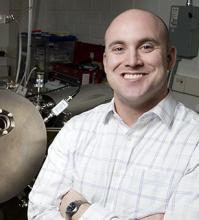Associate Professor, Dept. of Materials Science and Engineering at UC Berkeley; Faculty Scientist, Lawrence Berkeley National Laboratory

Professor Lane W. Martin is an Associate Professor of Materials Science and Engineering and a Faculty Scientist in the Materials Science Division at Lawrence Berkeley National Laboratory. Lane received his B. S. in Materials Science and Engineering from Carnegie Mellon University in Dec. 2003 and his M. S. and Ph.D. in Materials Science and Engineering from the University of California, Berkeley in 2006 and 2008, respectively. From 2008 to 2009, Lane served as a Postdoctoral Fellow in the Quantum Materials Program, Materials Science Division, Lawrence Berkeley National Laboratory. From 2009 to 2014, Lane was an Assistant Professor in the Department of Materials Science and Engineering at the University of Illinois, Urbana-Champaign. In 2014, Lane returned to the University of California, Berkeley as an Associate Professor. As of July 2017, Lane has published >165 papers, his work has been cited >10,340 times (resulting in an h-index of 44), and he has given >105 invited/plenary/keynote talks during his career. Lane’s work has garnered a number of awards including the Robert L. Coble Award for Young Scholars from the American Ceramic Society (2016), the American Association for Crystal Growth (AACG) Young Author Award (2015), the Presidential Early Career Award for Scientists and Engineers (2014), the Dean’s Award for Research Excellence for the University of Illinois, Urbana-Champaign (2013), the National Science Foundation CAREER Award (2012), the Army Research Office Young Investigator Program Award (2010), a National Science Foundation IGERT Fellowship in Nanoscale Science and Engineering (2004-2007), the Intel Robert Noyce Fellowship in Microelectronics (2007-2008), the Graduate Excellence in Materials Science Award (2006), and the Materials Research Society’s Gold Medal Award for Graduate Students (2006).
Talk Title:
Pyroelectric Energy Conversion – Overview and Demonstration of Novel Thermal-Energy Conversion
Talk Abstract:
"The need for improved utilization of energy resources is abundantly clear. In the United States alone, we are unable to utilize between 60-70% of all energy produced (from all sources, renewable or otherwise) due to inefficiencies in energy transport, device operation, etc. The vast majority of this lost energy is dissipated as heat or thermal losses. Harvesting even a small fraction of this energy would dramatically impact what is, along with such topics as water, healthcare, etc., one of the most pressing challenges that faces society today. In this spirit, a number of direct thermal-to-electric energy conversion technologies have been proposed and explored over the years with thermoelectric energy conversion being the most common and widely studied. One additional (and complementary) approach to thermal-to-electric energy conversion is so-called pyroelectric energy conversion (PEC) in which a solid-state heat engine transforms temporally-varying thermal signatures into electrical current. PEC is based on the pyroelectric effect which is the variation of remnant polarization P of a material as a function of temperature T at constant electric field E [(∂P/∂T)_E]. Efficient PEC requires operating the material using thermal-electrical cycles to produce sustained pyroelectric generation of electricity. Repeated extraction of electrical energy requires a cyclic temperature profile and conversion can be further enhanced by additionally applying an electric field as occurs in, for instance, a pyroelectric Ericsson cycle.
In this presentation, I will introduce the concept of PEC and provide a foundation for understanding what it takes to create high-performance pyroelectric materials and PEC devices. In particular, we will explore the fundamentals of the field- and temperature-dependent response of ferroelectric materials which are known to exhibit large pyroelectric response. We will examine recent insights into material design algorithms that can allow us to maximize PEC potential via control of both electrical/dielectric and pyroelectric responses that determine the figure of merit for such applications. Specifically we will discuss how compositional gradients in materials can be used to independently tune material properties thereby enabling the production of large figures of merit for PEC. Additionally, we will explore recent work wherein control of prototypical relaxor 0.68PbMg1/3Nb2/3O3-0.32PbTiO3 (PMN-PT) thin films has enabled the realization of large pyroelectric coefficients and suppression of dielectric response under applied fields. This, in turn, has yielded unprecedented figures of merit for PEC and devices yielding maximum energy density, power density, and efficiency of 1.06 J/cc, 526 W/cc, and 19% of Carnot, respectively. Future prospects for materials optimization for energy conversion will also be explored."
